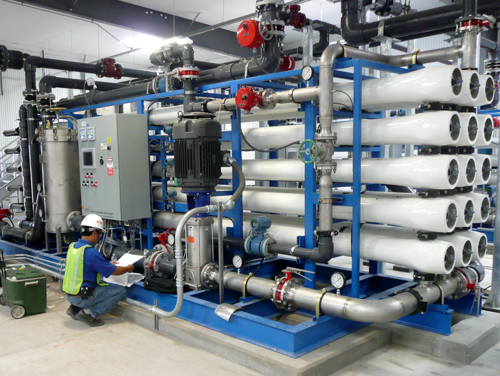How PFAS Treatment Reduces Environmental Impact and Improves Public Safety
Your Guide to PFAS Treatment Technologies and Perks
The prevalence of PFAS contamination in water sources requires a detailed understanding of offered treatment modern technologies. Each technology not only targets certain PFAS compounds yet also plays an important function in improving total water quality and securing environmental stability.
Understanding PFAS Contamination
Recognizing PFAS contamination is critical for resolving its prevalent effect on ecological and human wellness (m270 pfas treatment). Per- and polyfluoroalkyl substances (PFAS) are a group of synthetic chemicals commonly made use of in different commercial and customer items as a result of their water- and grease-resistant residential properties. Typically discovered in firefighting foams, non-stick pots and pans, and water-repellent textiles, PFAS have actually gotten in the atmosphere with manufacturing procedures, wastewater discharges, and seeping from land fills
As soon as launched, these materials continue the environment, bring about prevalent contamination of dirt and water resources. Their distinct chemical structure, identified by strong carbon-fluorine bonds, makes them resistant to deterioration, leading to a phenomenon known as "permanently chemicals." As a result, PFAS can build up in the body and the food cycle, possibly causing damaging health and wellness results, including body immune system disruption, developmental problems, and an enhanced threat of specific cancers cells.
Regulative companies and health companies are significantly acknowledging the relevance of PFAS contamination, motivating efforts to check, assess, and minimize its results. Understanding the pathways of PFAS contamination is crucial for educating public policy and creating efficient approaches to protect both environmental and human health.
Summary of Therapy Technologies
Numerous treatment modern technologies have actually been created to deal with the challenges postured by PFAS contamination in water and soil. These modern technologies can be extensively categorized into a number of categories, each with its one-of-a-kind devices and performance in getting rid of PFAS substances.
One prominent method is ion exchange, which makes use of resin products to catch and get rid of PFAS from polluted water. One more technology, advanced oxidation procedures (AOPs), utilizes solid oxidants and ultraviolet light to break down PFAS into less harmful compounds.

Turned On Carbon Filtering
Activated carbon purification is a widely used technique for the removal of PFAS from infected water, understood for its ability to adsorb a broad series of organic compounds. This technology employs activated carbon, a highly permeable material with a substantial surface, which assists in the binding of PFAS molecules with physical adsorption. The efficiency of turned on carbon in getting rid of PFAS is affected by a number of variables, consisting of the sort of carbon utilized, the get in touch with time, and the concentration of PFAS in the water.
One of the benefits of triggered carbon filtering is its flexibility; it can be carried out in numerous arrangements, such as granular turned on carbon (GAC) systems or powdered triggered carbon (PAC) systems. GAC systems are generally utilized in larger-scale applications, while special-interest group can be utilized in smaller sized or short-lived setups. Additionally, the technology is relatively simple to run and keep, making it available for several water therapy centers.

Ion Exchange Systems
Ion exchange systems stand for an additional effective strategy for the removal of PFAS from contaminated water, complementing techniques like activated carbon filtering. These systems run on the concept of trading ions in the water with ions hung on a resin material. Ion exchange resins can be specifically created to target the adversely billed PFAS substances, effectively capturing them and allowing cleaner water to travel through.
One of the main advantages of ion exchange systems is their capability to remove a vast variety of PFAS, including both long-chain and short-chain variants. This convenience makes them ideal for different applications, read this post here varying from local water therapy to industrial processes. Furthermore, ion exchange systems can frequently achieve lower detection restrictions for PFAS compared to a few other therapy techniques, thus enhancing water high quality.
Nonetheless, it is necessary to check and handle the regeneration of ion exchange media, as the efficiency can decrease in time because of saturation. Appropriate maintenance and substitute of the material are essential for maintaining the system's effectiveness. On her latest blog the whole, ion exchange systems provide a trustworthy and effective remedy for PFAS removal, adding substantially to secure drinking water standards and environmental management.
Advanced Oxidation Processes
Advanced Oxidation Processes (AOPs) use effective oxidants to successfully degrade PFAS substances in contaminated water. These ingenious therapy approaches generate very reactive species, such as hydroxyl radicals, that can damage down complicated PFAS molecules into less unsafe by-products. m270 pfas treatment. AOPs normally employ combinations of ultraviolet (UV) light, ozone, hydrogen peroxide, or Fenton's reagent, boosting the oxidation potential and boosting degradation performance
The key benefit of AOPs depends on their capability to target a wide series of PFAS substances, consisting of both long-chain and short-chain versions. This adaptability is crucial, as PFAS contamination typically entails combinations of different compounds with varying chemical structures. AOPs can be incorporated right into existing water therapy systems, making them a functional option for many districts and markets.
Nevertheless, the execution of AOPs can be resource-intensive, needing mindful consideration of operational prices and power consumption. Additionally, while AOPs work in damaging down PFAS, read what he said they might not totally get rid of all byproducts, demanding additional treatment actions - m270 pfas treatment. Generally, AOPs stand for an appealing opportunity for addressing PFAS contamination, contributing to cleaner water sources and boosted public health defense

Conclusion
By selecting the suitable innovation, neighborhoods can enhance water quality, shield public health, and alleviate the ecological dangers linked with PFAS exposure. Proceeded research study and implementation of these techniques are necessary for efficient administration of PFAS contamination in affected areas.